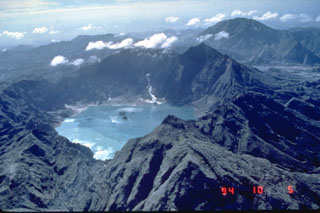Report on Pinatubo (Philippines) — December 1994
Bulletin of the Global Volcanism Network, vol. 19, no. 12 (December 1994)
Managing Editor: Richard Wunderman.
Pinatubo (Philippines) Alert status raised following increased seismicity in early January
Please cite this report as:
Global Volcanism Program, 1994. Report on Pinatubo (Philippines) (Wunderman, R., ed.). Bulletin of the Global Volcanism Network, 19:12. Smithsonian Institution. https://doi.org/10.5479/si.GVP.BGVN199412-273083
Pinatubo
Philippines
15.13°N, 120.35°E; summit elev. 1486 m
All times are local (unless otherwise noted)
On 7 January an explosion-type earthquake with a duration of 6 minutes and 40 seconds was recorded, beginning around 0506. This event was followed about 30 minutes later by low-frequency harmonic tremor that continued through 16 January. Seven high-frequency volcanic earthquakes were also recorded. A total of 16 explosion-type events and nine episodes of low-frequency harmonic tremor indicates shallow magma activity beneath the crater. Three high-frequency volcanic earthquakes were recorded on 9 January. Because of this seismicity, the alert status was raised to Alert Level 2 (magma intrusion). Although a heightened alert status was declared, PHIVOLCS believed that explosions would likely be confined to the caldera and no enlargement of the danger zone was made at this time.
Again on 10 January two high-frequency volcanic earthquakes were recorded, followed by one the next day. During an overflight on 11 January a barely recognizable explosion pit was observed at the N side of the 1992 lava dome; it is probably the site of the small phreatic explosions on 7 January 1994. Only weak emission of white steam was observed along pre-existing vents formed after the 1991 eruption. The number of daily explosion-type earthquakes increased during the next few days (events in parentheses): on 12 (11), 13 (7), 14 (15), 15 (30), and 16 January (15). Low-frequency harmonic tremor persisted throughout this period.
Geological Summary. Prior to 1991 Pinatubo volcano was a relatively unknown, heavily forested lava dome complex located 100 km NW of Manila with no records of historical eruptions. The 1991 eruption, one of the world's largest of the 20th century, ejected massive amounts of tephra and produced voluminous pyroclastic flows, forming a small, 2.5-km-wide summit caldera whose floor is now covered by a lake. Caldera formation lowered the height of the summit by more than 300 m. Although the eruption caused hundreds of fatalities and major damage with severe social and economic impact, successful monitoring efforts greatly reduced the number of fatalities. Widespread lahars that redistributed products of the 1991 eruption have continued to cause severe disruption. Previous major eruptive periods, interrupted by lengthy quiescent periods, have produced pyroclastic flows and lahars that were even more extensive than in 1991.
Information Contacts: R. Punongbayan and E. Corpuz, PHIVOLCS.

